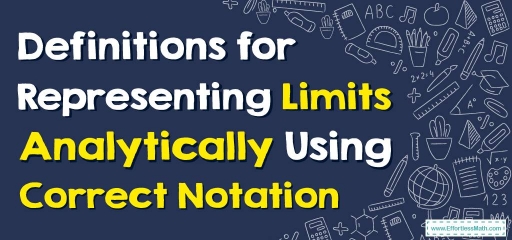How to Define Limits Analytically Using Correct Notation?
[include_netrun_products_block from-products="product/10-full-length-pert-math-practice-tests/" product-list-class="bundle-products float-left" product-item-class="float-left" product-item-image-container-class="p-0 float-left" product-item-image-container-size="col-2" product-item-image-container-custom-style="" product-item-container-size="" product-item-add-to-cart-class="btn-accent btn-purchase-ajax" product-item-button-custom-url="{{url}}/?ajax-add-to-cart={{id}}" product-item-button-custom-url-if-not-salable="{{productUrl}} product-item-container-class="" product-item-element-order="image,title,purchase,price" product-item-title-size="" product-item-title-wrapper-size="col-10" product-item-title-tag="h3" product-item-title-class="mt-0" product-item-title-wrapper-class="float-left pr-0" product-item-price-size="" product-item-purchase-size="" product-item-purchase-wrapper-size="" product-item-price-wrapper-class="pr-0 float-left" product-item-price-wrapper-size="col-10" product-item-read-more-text="" product-item-add-to-cart-text="" product-item-add-to-cart-custom-attribute="title='Purchase this book with single click'" product-item-thumbnail-size="290-380" show-details="false" show-excerpt="false" paginate="false" lazy-load="true"]

The Limits in maths are unique real numbers. Let’s consider a function with real value \(f\) and the real number \(a\), the limit is usually defined as the \(lim_{x\to a}{f(x)}=C\). It is read as “the limit of \(f\) of \(x\), as \(x\) approaches \(a\) equals \(C\)“ . The “lim” shows the limit.
Related Topics
- How to Estimate Limit Values from the Graph
- How to Select Procedures for Determining Limits
- Properties of Limits
A step-by-step guide to defining limits analytically using correct notation
Steps for Analytically Representing Limits Using the Correct Notation:
- The first step is to figure out what value \(x\) is close to. This value will be \(a\).
- The second step is to determine the function. \(f\) is the name of the function \((x)\).
- The third step is to write the right notation for the limit analytically.
An Analytical Notation for Expressing Limits Analytically:
- A limit is an output \((y)\) value a function will approach while approaching a certain input \((x)\) value.
- When an input value approaches zero, the limit notation is used to show how close a function is to reaching its output value.
To show a limit analytically in the correct way, it should be written in this way:
Defining Limits Analytically Using Correct Notation – Example 1:
Use correct notation to express the limit of \(f(x)=3x^2+2x-4\) as \(x\) approaches \(2\).
First, identify \(a\) value → \(a=2\)
Then, identify \(f(x)\) → \(f(x)=3x^2+2x-4\)
Now, write the correct notation:
\(lim_{x\to 2}{(3x^2+2x-4)}=C\)
Defining Limits Analytically Using Correct Notation – Example 2:
Use correct notation to express the limit of \(f(x)=x^4+10x+5\) as \(x\) approaches \(-3\).
First, identify \(a\) value → \(a=-3\)
Then, identify \(f(x)\) → \(f(x)=x^4+10x+5\)
Now, write the correct notation:
\(lim_{x\to -3}{(x^4+10x+5)}=C\)
Exercises for Defining Limits Analytically Using Correct Notation
- Use correct notation to express the limit of \(f(x)=-3x-7x^2+20\) as \(x\) approaches \(12\).
- Use correct notation to express the limit of \(f(x)=-6x^3-5x+11\) as \(x\) approaches \(-6\).
- Use correct notation to express the limit of \(f(x)=5x^2+8x-3\) as \(x\) approaches \(-4\).
- Use correct notation to express the limit of \(f(x)=25x^5+22x^2-13\) as \(x\) approaches \(5\).
- \(\color{blue}{\lim_{x\to 12}(-3x-7x^2+20)=C}\)
- \(\color{blue}{\lim_{x\to -6}(-6x^3-5x+11)=C}\)
- \(\color{blue}{\lim_{x\to -4}(5x^2+8x-3)=C}\)
- \(\color{blue}{\lim_{x\to 5}(25x^5+22x^2-13)=C}\)
Related to This Article
More math articles
- Cooking with Fractions: A Guide to Learn How to Adding and Subtracting Fractions in Recipes
- Pre-Algebra Formulas
- How to Handle Your Math Assignments?
- 3rd Grade ACT Aspire Math Worksheets: FREE & Printable
- 3rd Grade NHSAS Math Worksheets: FREE & Printable
- Tips for Learning Mathematics for the Humanitarians
- 6th Grade MCAS Math Worksheets: FREE & Printable
- How to Identify Independent and Dependent Events?
- Using Strip Models to Solve Percentage Problems
- How to Use Area Models to Divide Two-Digit Numbers By One-digit Numbers



























What people say about "How to Define Limits Analytically Using Correct Notation? - Effortless Math: We Help Students Learn to LOVE Mathematics"?
No one replied yet.